Xavier Alameda-Pineda
ROBOTLEARN
Modeling strategies for speech enhancement in the latent space of a neural audio codec
Oct 30, 2025Abstract:Neural audio codecs (NACs) provide compact latent speech representations in the form of sequences of continuous vectors or discrete tokens. In this work, we investigate how these two types of speech representations compare when used as training targets for supervised speech enhancement. We consider both autoregressive and non-autoregressive speech enhancement models based on the Conformer architecture, as well as a simple baseline where the NAC encoder is simply fine-tuned for speech enhancement. Our experiments reveal three key findings: predicting continuous latent representations consistently outperforms discrete token prediction; autoregressive models achieve higher quality but at the expense of intelligibility and efficiency, making non-autoregressive models more attractive in practice; and encoder fine-tuning yields the strongest enhancement metrics overall, though at the cost of degraded codec reconstruction. The code and audio samples are available online.
Posterior Transition Modeling for Unsupervised Diffusion-Based Speech Enhancement
Jul 03, 2025

Abstract:We explore unsupervised speech enhancement using diffusion models as expressive generative priors for clean speech. Existing approaches guide the reverse diffusion process using noisy speech through an approximate, noise-perturbed likelihood score, combined with the unconditional score via a trade-off hyperparameter. In this work, we propose two alternative algorithms that directly model the conditional reverse transition distribution of diffusion states. The first method integrates the diffusion prior with the observation model in a principled way, removing the need for hyperparameter tuning. The second defines a diffusion process over the noisy speech itself, yielding a fully tractable and exact likelihood score. Experiments on the WSJ0-QUT and VoiceBank-DEMAND datasets demonstrate improved enhancement metrics and greater robustness to domain shifts compared to both supervised and unsupervised baselines.
AnCoGen: Analysis, Control and Generation of Speech with a Masked Autoencoder
Jan 09, 2025Abstract:This article introduces AnCoGen, a novel method that leverages a masked autoencoder to unify the analysis, control, and generation of speech signals within a single model. AnCoGen can analyze speech by estimating key attributes, such as speaker identity, pitch, content, loudness, signal-to-noise ratio, and clarity index. In addition, it can generate speech from these attributes and allow precise control of the synthesized speech by modifying them. Extensive experiments demonstrated the effectiveness of AnCoGen across speech analysis-resynthesis, pitch estimation, pitch modification, and speech enhancement.
Diffusion-based Unsupervised Audio-visual Speech Enhancement
Oct 04, 2024Abstract:This paper proposes a new unsupervised audiovisual speech enhancement (AVSE) approach that combines a diffusion-based audio-visual speech generative model with a non-negative matrix factorization (NMF) noise model. First, the diffusion model is pre-trained on clean speech conditioned on corresponding video data to simulate the speech generative distribution. This pre-trained model is then paired with the NMF-based noise model to iteratively estimate clean speech. Specifically, a diffusion-based posterior sampling approach is implemented within the reverse diffusion process, where after each iteration, a speech estimate is obtained and used to update the noise parameters. Experimental results confirm that the proposed AVSE approach not only outperforms its audio-only counterpart but also generalizes better than a recent supervisedgenerative AVSE method. Additionally, the new inference algorithm offers a better balance between inference speed and performance compared to the previous diffusion-based method.
Lost and Found: Overcoming Detector Failures in Online Multi-Object Tracking
Jul 16, 2024Abstract:Multi-object tracking (MOT) endeavors to precisely estimate the positions and identities of multiple objects over time. The prevailing approach, tracking-by-detection (TbD), first detects objects and then links detections, resulting in a simple yet effective method. However, contemporary detectors may occasionally miss some objects in certain frames, causing trackers to cease tracking prematurely. To tackle this issue, we propose BUSCA, meaning `to search', a versatile framework compatible with any online TbD system, enhancing its ability to persistently track those objects missed by the detector, primarily due to occlusions. Remarkably, this is accomplished without modifying past tracking results or accessing future frames, i.e., in a fully online manner. BUSCA generates proposals based on neighboring tracks, motion, and learned tokens. Utilizing a decision Transformer that integrates multimodal visual and spatiotemporal information, it addresses the object-proposal association as a multi-choice question-answering task. BUSCA is trained independently of the underlying tracker, solely on synthetic data, without requiring fine-tuning. Through BUSCA, we showcase consistent performance enhancements across five different trackers and establish a new state-of-the-art baseline across three different benchmarks. Code available at: https://github.com/lorenzovaquero/BUSCA.
MEGA: Masked Generative Autoencoder for Human Mesh Recovery
May 29, 2024Abstract:Human Mesh Recovery (HMR) from a single RGB image is a highly ambiguous problem, as similar 2D projections can correspond to multiple 3D interpretations. Nevertheless, most HMR methods overlook this ambiguity and make a single prediction without accounting for the associated uncertainty. A few approaches generate a distribution of human meshes, enabling the sampling of multiple predictions; however, none of them is competitive with the latest single-output model when making a single prediction. This work proposes a new approach based on masked generative modeling. By tokenizing the human pose and shape, we formulate the HMR task as generating a sequence of discrete tokens conditioned on an input image. We introduce MEGA, a MaskEd Generative Autoencoder trained to recover human meshes from images and partial human mesh token sequences. Given an image, our flexible generation scheme allows us to predict a single human mesh in deterministic mode or to generate multiple human meshes in stochastic mode. MEGA enables us to propose multiple outputs and to evaluate the uncertainty of the predictions. Experiments on in-the-wild benchmarks show that MEGA achieves state-of-the-art performance in deterministic and stochastic modes, outperforming single-output and multi-output approaches.
Socially Pertinent Robots in Gerontological Healthcare
Apr 11, 2024
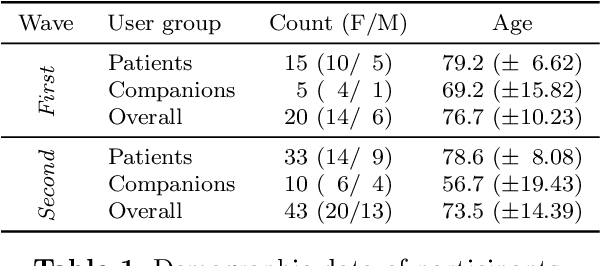
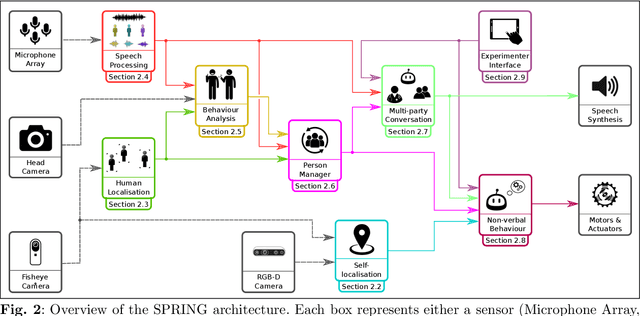
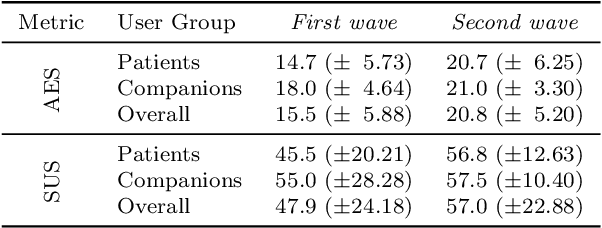
Abstract:Despite the many recent achievements in developing and deploying social robotics, there are still many underexplored environments and applications for which systematic evaluation of such systems by end-users is necessary. While several robotic platforms have been used in gerontological healthcare, the question of whether or not a social interactive robot with multi-modal conversational capabilities will be useful and accepted in real-life facilities is yet to be answered. This paper is an attempt to partially answer this question, via two waves of experiments with patients and companions in a day-care gerontological facility in Paris with a full-sized humanoid robot endowed with social and conversational interaction capabilities. The software architecture, developed during the H2020 SPRING project, together with the experimental protocol, allowed us to evaluate the acceptability (AES) and usability (SUS) with more than 60 end-users. Overall, the users are receptive to this technology, especially when the robot perception and action skills are robust to environmental clutter and flexible to handle a plethora of different interactions.
VQ-HPS: Human Pose and Shape Estimation in a Vector-Quantized Latent Space
Dec 13, 2023



Abstract:Human Pose and Shape Estimation (HPSE) from RGB images can be broadly categorized into two main groups: parametric and non-parametric approaches. Parametric techniques leverage a low-dimensional statistical body model for realistic results, whereas recent non-parametric methods achieve higher precision by directly regressing the 3D coordinates of the human body. Despite their strengths, both approaches face limitations: the parameters of statistical body models pose challenges as regression targets, and predicting 3D coordinates introduces computational complexities and issues related to smoothness. In this work, we take a novel approach to address the HPSE problem. We introduce a unique method involving a low-dimensional discrete latent representation of the human mesh, framing HPSE as a classification task. Instead of predicting body model parameters or 3D vertex coordinates, our focus is on forecasting the proposed discrete latent representation, which can be decoded into a registered human mesh. This innovative paradigm offers two key advantages: firstly, predicting a low-dimensional discrete representation confines our predictions to the space of anthropomorphic poses and shapes; secondly, by framing the problem as a classification task, we can harness the discriminative power inherent in neural networks. Our proposed model, VQ-HPS, a transformer-based architecture, forecasts the discrete latent representation of the mesh, trained through minimizing a cross-entropy loss. Our results demonstrate that VQ-HPS outperforms the current state-of-the-art non-parametric approaches while yielding results as realistic as those produced by parametric methods. This highlights the significant potential of the classification approach for HPSE.
Mixture of Dynamical Variational Autoencoders for Multi-Source Trajectory Modeling and Separation
Dec 07, 2023
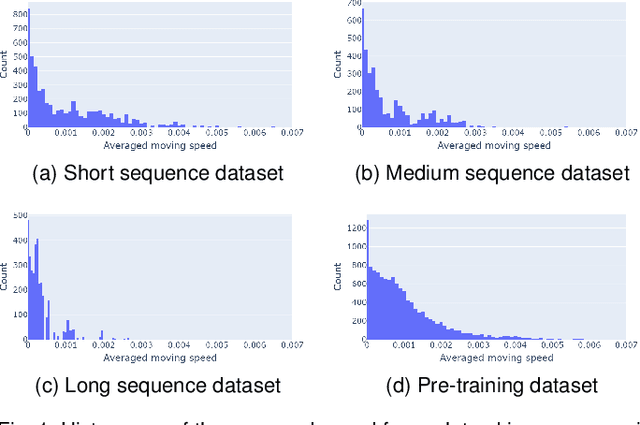

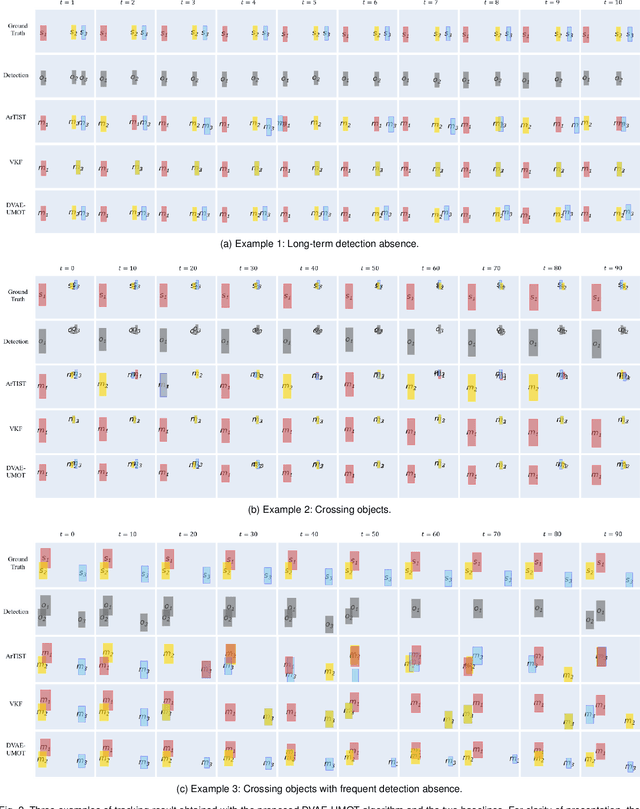
Abstract:In this paper, we propose a latent-variable generative model called mixture of dynamical variational autoencoders (MixDVAE) to model the dynamics of a system composed of multiple moving sources. A DVAE model is pre-trained on a single-source dataset to capture the source dynamics. Then, multiple instances of the pre-trained DVAE model are integrated into a multi-source mixture model with a discrete observation-to-source assignment latent variable. The posterior distributions of both the discrete observation-to-source assignment variable and the continuous DVAE variables representing the sources content/position are estimated using a variational expectation-maximization algorithm, leading to multi-source trajectories estimation. We illustrate the versatility of the proposed MixDVAE model on two tasks: a computer vision task, namely multi-object tracking, and an audio processing task, namely single-channel audio source separation. Experimental results show that the proposed method works well on these two tasks, and outperforms several baseline methods.
On the Effectiveness of LayerNorm Tuning for Continual Learning in Vision Transformers
Aug 18, 2023



Abstract:State-of-the-art rehearsal-free continual learning methods exploit the peculiarities of Vision Transformers to learn task-specific prompts, drastically reducing catastrophic forgetting. However, there is a tradeoff between the number of learned parameters and the performance, making such models computationally expensive. In this work, we aim to reduce this cost while maintaining competitive performance. We achieve this by revisiting and extending a simple transfer learning idea: learning task-specific normalization layers. Specifically, we tune the scale and bias parameters of LayerNorm for each continual learning task, selecting them at inference time based on the similarity between task-specific keys and the output of the pre-trained model. To make the classifier robust to incorrect selection of parameters during inference, we introduce a two-stage training procedure, where we first optimize the task-specific parameters and then train the classifier with the same selection procedure of the inference time. Experiments on ImageNet-R and CIFAR-100 show that our method achieves results that are either superior or on par with {the state of the art} while being computationally cheaper.
 Add to Chrome
Add to Chrome Add to Firefox
Add to Firefox Add to Edge
Add to Edge